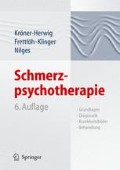Auszug
Hypnose gehört zu den ältesten Methoden psychologischer Schmerzkontrolle. Nach einem kurzen historischen Rückblick und der Definition von Hypnose werden Techniken zur hypnotischen Schmerzkontrolle beschrieben. Diese lassen sich in dissoziative, assoziative, symbolische und psychodynamische Techniken gliedern, ihre Anwendung ist symptom-oder problemorientiert. Anschließend werden experimentelle und klinische Studien sowie eine Metaanalyse referiert. Es wird gezeigt, dass hypnotische Schmerzkontrolle eine effektive Technik ist, die allerdings bestimmten Einschränkungen unterliegt.
Access this chapter
Tax calculation will be finalised at checkout
Purchases are for personal use only
Preview
Unable to display preview. Download preview PDF.
Literatur
Bongartz W, Flammer E, Schwonke R (2002) Die Effektivität der Hypnose:Eine meta-analytische Studie. Psychotherapeut 47/2: 76–76
Crawford HJ, Knebel T, Vendemia JMC (1998) The nature of hypnotic analgesia: Neurophysiological foundation and evidence. Cont Hypn 15: 22–33
Faymonville ME, Mambourg PH, Joris J et al. (1997) Psychological approaches during conscious sedation. Hypnosis vs. stress reducing strategies: A prospective randomized study. Pain 73: 361–367
Friederich M, Trippe RH, Özcan M, Weiß T, Hecht H, Miltner WHR (2002) Hypnotische Analgesie und Aufmerksamkeitsablenkung: Identische oder unterschiedliche Mechanismen kortikaler Schmerzkontrolle? HyKog 19: 63–77
Haahnen HC, Hoendors HAT, Hop WC, Hekster B (1991) Controlled trial of hypnotherapy in the treatment of refractory fibromyalgia. J Rheumatol 18: 72–75
Hilgard ER (1965) Hypnotic susceptibility. Harcourt, Brace, World, New York
Hilgard ER (1969) Pain as a puzzle for psychology and physiology. Am Psychologist 24: 103–113
Hilgard ER (1977) Divided Consciousness: Multiple controls in human thought and action. Wiley, New York
Hilgard ER (1989) Eine Neodissoziationstheorie des geteilten Bewusstseins. HyKog 6/2: 3–20
Hilgard ER, Hilgard JR (1975) Hypnosis in the relief of pain. Kaufmann, Los Altos
Kiernan BD, Dane JR, Phillips LH, Price DD (1995) Hypnotic analgesia reduces R-III nociceptive reflex: Further evidence concerning the multifactorial nature of hypnotic analgesia. Pain 60: 39–47
Kosslyn SM, Thompson WL, Costantini-Ferrando MF, Alpert NM, Spiegel D (2000) Hypnotic visual illusion alters color processing in the brain. Am J Psych 157: 279–1284
Lang EV, Benotsch EG, Fick LJ et al. (2000) Adjunctive non-pharmacological analgesia for invasive medical procedures: A randomised trial. Lancet 355: 1486–1500
Mehrstedt M (Hrsg) (1999) Zahnärztliche Hypnose. HyKog 16
Miller ME, Bowers KE (1986) Hypnotic analgesia and stress inoculation in the reduction of pain. J Abnorm Psychol 95: 6–14
Montgomery GH, DuHamel KN, Redd WH (2000) A meta-analysis of hypnotically induced analgesia: How effective is hypnosis? Int J Clin Exp Hypn 48: 138–153
Montgomery GH, Weltz CR, Seltz M, Bovbjer DH (2002) Brief presurgery hypnosis reduces distress and pain in excisional biopsy patients. Int J Clin Exp Hypn 50: 17–32
Patterson DR, Everett JJ, Burns GL, Marvin JA (1992) Hypnosis for the treatment of burn pain. J Consult Clin Psych 60: 713–117
Peter B (1998) Möglichkeiten und Grenzen der Hypnose in der Schmerzbehandlung. Schmerz 12: 179–186
Peter B (1999) Dammschmerzen. Das Scheitern einer psychologischen Behandlung. In: Kröner-Herwig B, Franz C, Geissner E (Hrsg) Psychologische Behandlung chronischer Schmerzsyndrome. Thieme, Stuttgart, S 163–176
Peter B (2001a) Zur Geschichte der Hypnose in Deutschland. HyKog 17: 47–106
Peter B (2001b) Altersregression. In: Revenstorf D, Peter B (Hrsg) Hypnose in Psychotherapie, Psychosomatik und Medizin. Springer, Heidelberg
Peter B (2006) Hypnotherapie bei der Behandlung posttraumatischer Belastungsstörung. In: Maercker A, Rosner R (Hrsg) Psychotherapie der posttraumatischen Belastungsstörung. Thieme, Stuttgart
Peter B, Kraiker C, Revenstorf D (Hrsg) (1991) Hypnose und Verhaltenstherapie. Huber, Bern
Primavera JP, Kaiser RS (1992) Non-pharmacological treatment of headache: Is less more? Headache 32: 393
Rainville P, Carrier B, Hofbauer RK, Bushnell MC, Duncan GH (1999) Dissociation of sensory and affective dimensions of pain using hypnotic modulation. Pain 82: 150–171
Rainville R Duncan GH, Price DD, Carrier B, Bushnell MC (1997) Pain affect encoded in human anterior cingulate but not somatosensory cortex. Science 277: 968–971
Revenstorf D, Peter B (Hrsg) (2001) Hypnose in Psychotherapie, Psychosomatik und Medizin. Springer, Heidelberg
Ter Kuile MM, Spinhoven P, Linssen ACG, Zitman FG et al. (1994) Autogenic training and cognitive self-hypnosis for the treatment of recurrent headaches in three different subject groups. Pain 58: 331
Whorwell PJ, Prior A, Faragher EB (1984) Controlled trial of hypnotherapy in the treatment of severe refractory irritable bowel syndrom. Lancet II: 1232–1234
Author information
Authors and Affiliations
Editor information
Editors and Affiliations
Rights and permissions
Copyright information
© 2007 Springer Medizin Verlag Heidelberg
About this chapter
Cite this chapter
Peter, B. (2007). Hypnose. In: Kröner-Herwig, B., Frettlöh, J., Klinger, R., Nilges, P. (eds) Schmerzpsychotherapie. Springer, Berlin, Heidelberg. https://doi.org/10.1007/978-3-540-72284-7_32
Download citation
DOI: https://doi.org/10.1007/978-3-540-72284-7_32
Publisher Name: Springer, Berlin, Heidelberg
Print ISBN: 978-3-540-72281-6
Online ISBN: 978-3-540-72284-7
eBook Packages: Medicine (German Language)

